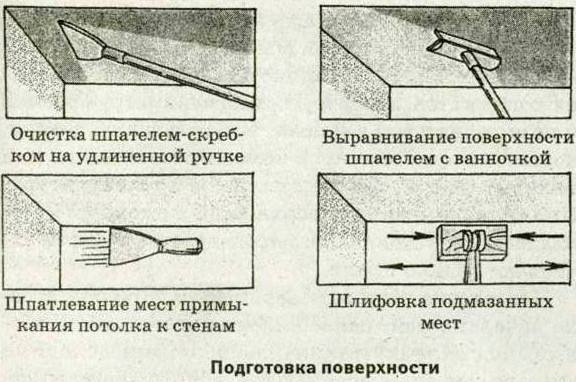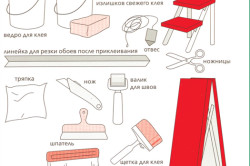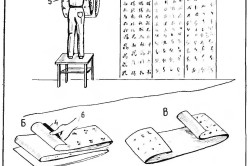What kind of wallpaper can be glued to the kitchen?
- Criteria for choosing wallpaper for the kitchen
- Wallpaper density
- High level of lightfastness
- Vapor permeability
- What kind of kitchen flooring can not be taken?
- Varieties of wallpaper for the kitchen
- Silkscreen or fiberglass?
To create a cozy atmosphere in the kitchen, you can use various finishing materials. Wallpaper, which at one time was undeservedly considered an obsolete type of coverage, completely inconsistent with modern design, is again at the peak of popularity.
Wallpaper for the kitchen should be chosen moisture resistant, and even better washable.
Many world-famous designers use this type of material to create unusual, modern and stylish interiors. The advantages of wallpaper include the fact that the coating is produced in a huge assortment, it can vary in materials of manufacture, color and texture. Wallpaper is glued to the wall very simply, it does not take much time and experience.
What is the best wallpaper to glue the kitchen to make it practical and beautiful? Attention should be paid not only to the types of coverage, but also to how to choose wallpaper for the kitchen, what color schemes are most suitable for finishing.
Criteria for choosing wallpaper for the kitchen

To choose a coating, you need to pay attention to some parameters. This is required for the reason that the surfaces are constantly exposed to the negative effects of high levels of humidity, temperature changes, the presence of steam, splashes of grease. That is why it is necessary to choose a coating that is durable, resistant to such types of exposure, to mold, moisture.
Today, manufacturers offer a huge selection of wallpapers that are ideal for the kitchen. They can be washed, they easily transfer water that has fallen on the surface, juices, traces of food. There are varieties of coatings that can even be brushed, while their front surface does not lose its appearance at all.
Among the selection criteria, the following should be noted:
Back to index
Wallpaper density
To resolve the issue of how to glue wallpaper in the kitchen, attention must be paid to ensuring that the coating lasts for a long time, and does not have to be changed after a year. Coatings with high density have a minimum number of pores, which means that dirt will not clog in them, and the service life will increase. It will be difficult to damage this coating, it will not be cut, torn, and this is important for kitchen wallpaper, especially in the work area.
Back to index
High level of light fastness
It is required that the coating is resistant to light, does not turn yellow, and the pattern does not fade. If you do not comply with this condition, then even a beautiful interior will soon become unattractive.
Back to index
Vapor permeability

Wallpaper in the kitchen should ensure the normal removal of excess moisture from the room, since the humidity level here is quite high. So that the walls do not sweat, do not become covered with mold, it is necessary to take coatings that will ensure proper air exchange.
If you choose vinyl wallpaper for painting, then you need to take only those that can withstand the repeated staining process. They are more durable, have a high level of resistance to mechanical damage. There should be a special icon on the roll, which means that it can be used specifically for kitchens and dining rooms.
Back to index
What kind of kitchen flooring can not be taken?
When deciding what wallpaper to glue the kitchen with, it must be taken into account that there are a number of coatings that are completely unsuitable for this. These include paper wallpapers. Although they have a beautiful appearance and low price, they are completely unsuitable for use. In the kitchen you need to buy something more practical.

Why exactly? The fact is that this type of coating is not intended for use in kitchens. The paper web is not so practical, despite the fact that it is made entirely of natural material. The problem is that even special impregnation does not make paper-based wallpaper more durable.
The coating absorbs different odors too much, burnt from oil, and from moisture they simply become covered with bubbles, they begin to lag behind the surface. Paper canvases are also not resistant to light, as a result, the pattern quickly burns out, the surface becomes faded.
In addition to paper materials, bamboo, made from natural plant components, and rare wood veneer are not suitable for the kitchen.
All of them look spectacular and stylish, but they are absolutely not ideal for the kitchen, as they quickly become unusable.
Back to index
Varieties of wallpaper for the kitchen
Before sticking wallpaper in the kitchen, you need to choose the right one. Manufacturers today offer a variety of options, but paper coatings, even with special impregnation, will not last long, after 3-4 years you will have to make cosmetic repairs. They quickly fade, their appearance becomes unattractive. This indicates that a small gain in price is not at all worth the fact that the appearance of the coating will soon be spoiled.
But today you can find other types of coatings on sale that are fully consistent with the kitchen:

- Foamed vinyl covers. This is a type of wallpaper that is made from moisture-resistant material. Although the manufacturer proudly claims that such material is optimal for kitchens, it cannot be called too durable. Vinyl is very thin, it can only decorate the dining area, and for a worker it is better to look for a more durable material. Such wallpapers are usually decorated only with drawings on a gastronomic theme; their choice is not very large.
- Ordinary vinyl wallpaper. This type of material for the kitchen is more suitable: it is not afraid of moisture at all, it has sufficient density to withstand various types of impacts. Choosing vinyl wallpaper for such a room is not difficult, just take a piece of the coating, and then squeeze it with your hands. If the roll is easily crumpled, then it is better not to use it for the kitchen. Of the advantages of using vinyl wallpaper, it should be noted that they are resistant to moisture and light, and are not subject to the negative effects of mold. Wallpaper of this type is easily glued to the wall.
- Wallpaper from compact vinyl. These are hot stamping coatings, most suitable for finishing the kitchen space. The canvas allows you to imitate various materials (for example, textiles, natural leather, stone, textured plaster). With the help of compact vinyl, you can create with your own hands any, even the most daring and unusual interior, without significant financial costs. This material is durable, it remarkably hides wall defects, but its cost is higher than that of other coatings. However, the stylish appearance, the widest possibilities for design, and excellent performance justify some excess cost.
- Non-woven wallpaper. The kitchen may well be decorated with non-woven wallpaper. This is a dense and heavy coating, which has many positive properties. Interlining is a non-woven fabric that has numerous positive properties. This coating does not wrinkle or tear at all, it is resistant to many types of impact, perfectly masks wall defects. But for interior decoration it is necessary to use only special wallpaper glue, which is able to cope with a rather large weight of the canvas. The gluing technique is also different. The glue is applied to the surface of the wall, after which the dry canvases are simply pressed and smoothed over the walls.
